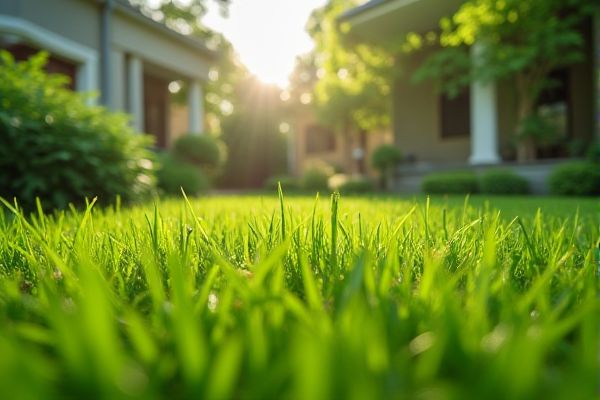
Micro clover lawns offer superior drought tolerance and reduced need for fertilizers compared to traditional grass lawns, promoting eco-friendly maintenance and a lush green appearance. Discover how choosing between micro clover and grass lawns can impact Your outdoor space by reading the rest of the article.
Table of Comparison
| Feature | Micro Clover Lawn | Grass Lawn |
|---|---|---|
| Water Usage | Low - drought tolerant | High - requires frequent watering |
| Maintenance | Low - minimal mowing and fertilizing | Moderate to high - regular mowing and fertilization needed |
| Growth Rate | Slow to moderate | Moderate to fast |
| Soil Enrichment | Fixes nitrogen naturally | No nitrogen fixation |
| Durability | Moderate - tolerates light foot traffic | High - suitable for heavy foot traffic |
| Appearance | Dense, green, soft texture | Varies - can be lush or patchy depending on care |
| Pest Resistance | High - fewer pests | Variable - prone to pests and diseases |
| Cost | Moderate initial cost, low upkeep | Varies - often lower initial cost, higher maintenance over time |
| Environmental Impact | Eco-friendly - reduces need for chemicals and watering | Higher impact - often requires fertilizers, pesticides, and water |
Introduction to Micro Clover Lawns vs Traditional Grass Lawns
Micro clover lawns offer enhanced drought resistance, nitrogen-fixing capabilities, and reduced need for synthetic fertilizers compared to traditional grass lawns. Unlike conventional turfgrass, micro clover creates a denser, greener lawn with lower maintenance requirements and improved soil health. This sustainable alternative supports environmental benefits while providing a resilient ground cover suitable for various climates.
Key Differences Between Micro Clover and Grass Lawns
Micro clover lawns require less water and fertilizer compared to traditional grass lawns, making them more eco-friendly and cost-effective. Their natural nitrogen-fixing ability improves soil health, reducing the need for chemical treatments that are typical in maintaining grass lawns. You benefit from a low-maintenance, drought-resistant lawn that stays green longer while supporting pollinators and enhancing biodiversity.
Environmental Benefits of Micro Clover Lawns
Micro clover lawns enhance soil health by fixing nitrogen naturally, reducing the need for synthetic fertilizers and lowering environmental pollution. Their drought tolerance and deep roots improve water retention, decreasing irrigation requirements compared to traditional grass lawns. Choosing micro clover for your lawn supports biodiversity by attracting pollinators and beneficial insects, promoting a healthier ecosystem.
Maintenance Requirements: Micro Clover vs Grass
Micro clover lawns require significantly less maintenance than traditional grass lawns due to their natural ability to fix nitrogen, reducing the need for fertilization and frequent watering. Unlike grass, micro clover grows densely with less mowing frequency and is more resistant to drought and pests, lowering overall upkeep efforts. Choosing micro clover can save you time and resources while maintaining a lush, green lawn with minimal intervention.
Drought Tolerance and Water Needs
Micro clover lawns require significantly less water than traditional grass lawns due to their excellent drought tolerance and deep root systems that retain moisture efficiently. Unlike grass lawns, micro clover fixes nitrogen naturally, reducing the need for frequent irrigation and fertilizers, which helps conserve water resources. Choosing a micro clover lawn can optimize your landscape's water efficiency while maintaining a green, resilient surface during dry periods.
Aesthetic Appeal and Lawn Appearance
Micro clover lawns offer a vibrant, textured aesthetic with fine green leaves that create a dense, uniform carpet, enhancing your garden's visual appeal. Grass lawns, while traditional, often show variations in color and texture, which can lead to patchiness and a less consistent appearance. Choosing micro clover can result in a lush, naturally bright lawn that retains its color better during drought conditions compared to typical grass varieties.
Impact on Soil Health and Fertility
Micro clover lawns enhance soil health by naturally fixing atmospheric nitrogen, reducing the need for synthetic fertilizers and improving soil fertility over time. Traditional grass lawns often require regular nitrogen supplementation, which can lead to soil nutrient depletion and increased chemical runoff. Choosing micro clover supports sustainable soil management, promoting a healthier, more resilient lawn ecosystem for your property.
Cost Comparison: Installation and Upkeep
Micro clover lawns typically incur lower installation costs due to reduced need for soil preparation and less frequent reseeding compared to traditional grass lawns. Upkeep expenses are minimized with micro clover as it requires fewer fertilizers, less watering, and reduced mowing frequency, translating to substantial long-term savings. Conversely, conventional grass lawns often demand higher maintenance costs stemming from regular fertilization, irrigation, and mowing to maintain optimal health and appearance.
Common Pests and Disease Resistance
Micro clover lawns exhibit superior resistance to common pests such as grubs and chinch bugs compared to traditional grass lawns, reducing the need for chemical treatments. The dense, low-growing nature of micro clover minimizes fungal infections like dollar spot and brown patch by promoting better air circulation and moisture regulation. Grass lawns often require more frequent pesticide and fungicide applications due to their vulnerability to pests and diseases, increasing maintenance efforts and environmental impact.
Choosing the Best Lawn Option for Your Yard
Micro clover lawns require less water, fertilizer, and mowing compared to traditional grass lawns, making them an eco-friendly choice that promotes soil health and reduces maintenance. Traditional grass lawns offer a classic aesthetic and can withstand heavy foot traffic better, ideal for areas frequented by pets or children. Your decision should consider factors like climate, yard usage, and maintenance preferences to select the lawn option that best suits your outdoor space.
 homyna.com
homyna.com